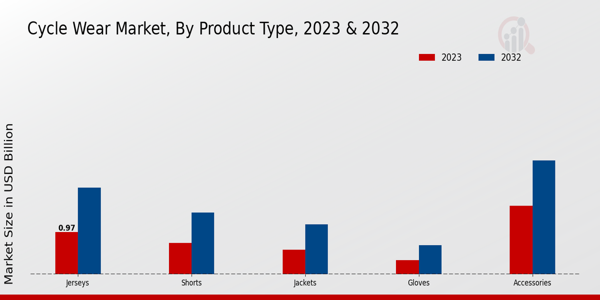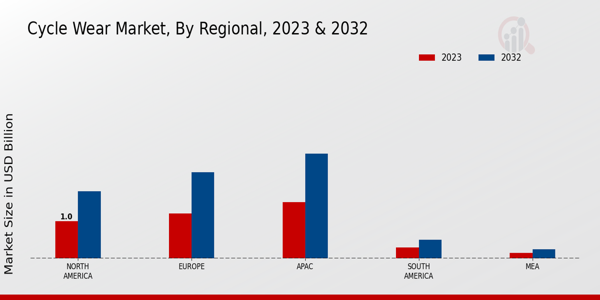Global Cycle Wear Market Overview
The Cycle Wear Market Size was estimated at 4.78 (USD Billion) in 2024. The Cycle Wear Market Industry is expected to grow from 5.13 (USD Billion) in 2025 to 9.72 (USD Billion) by 2034. The Cycle Wear Market CAGR (growth rate) is expected to be around 7.36% during the forecast period (2025 - 2034).

Source Primary Research, Secondary Research, MRFR Database and Analyst Review
Key Cycle Wear Market Trends Highlighted
The Cycle Wear Market is influenced by several key market drivers, including the increasing participation in cycling as both a recreational activity and a competitive sport. The growing emphasis on fitness and health, coupled with environmental awareness, has prompted more individuals to choose cycling over other modes of transport. This shift not only fosters a healthier lifestyle but also supports sustainability initiatives. Furthermore, advancements in fabric technology and design have led to the development of more comfortable and functional cycling apparel, making it appealing to a wider audience. Opportunities within the market are vast, particularly in the areas of customization and eco-friendly materials.Cycle apparel crafted from organic or recycled materials is a great way for brands to meet the growing demand for eco-friendly goods. Another fresh opportunity for advancement is the new trend of "smart clothing," which combines elements of safety measures with performance monitoring technology. Another great way to boost exposure and build brand loyalty is to team up with influential people and local bike groups. More and more, people are ditching the old-fashioned style of cycling apparel in favor of brighter colors and more fashionable patterns. Customers are looking for cycling attire that can go from performance to casual wear with ease, which means fashion is having a bigger impact on cycling gear.Social media platforms play a crucial role in showcasing these trends and connecting brands to a larger audience. Moreover, the rise of online shopping has made cycle wear more accessible, allowing consumers to explore a diverse range of products from various brands without geographical limitations. This evolution in consumer behavior and product offering will shape the future of the Cycle Wear Market significantly.
Cycle Wear Market Drivers
Growing Health Consciousness and Fitness Trends
The increasing awareness of health and fitness among individuals is a primary driver for the Cycle Wear Market Industry. As people seek to lead healthier lifestyles, cycling has emerged as one of the most effective ways to combine exercise with transport. This transition towards cycling not only supports personal health goals but also mitigates environmental concerns related to transportation. More individuals are investing in quality cycle wear that enhances their performance, comfort, and safety during rides, spurred by a burgeoning culture that prioritizes fitness and well-being.The industry's response has been the creation of innovative, high-performance cycle clothing designed to meet the needs of various cycling disciplines, from casual riding to competitive racing. Furthermore, the advent of smart technologies in cycle wear, such as temperature regulation and moisture-wicking fabrics, has made cycling apparel more appealing. As cycling becomes a more popular recreational and fitness activity ly, the demand for specialized cycle wear is poised to grow significantly, demonstrating a positive impact on market growth.
Rising Popularity of Cycling as a Recreational Activity
The Cycle Wear Market Industry is witnessing a surge in cycling as a favored recreational activity among various demographics. With cities promoting cycling as an eco-friendly transportation alternative, there is increasing investment in cycling infrastructure, like bike lanes and rental services. As more people engage in cycling to explore their surroundings, enjoy the outdoors, or participate in community events, the market for cycling apparel continues to expand.This trend not only boosts demand for stylish and functional cycle wear but also encourages manufacturers to innovate and provide diverse options catering to casual riders and enthusiasts alike.
Technological Advancements in Cycle Wear Materials
Technological innovation plays a critical role in advancing the Cycle Wear Market Industry, with new materials enhancing performance and user experience. Developments in fabric technology, such as breathable, lightweight, and waterproof materials, have significantly improved the quality of cycle wear. These innovations cater to a wide range of cycling environments and conditions, appealing to diverse consumer needs. As athletes and casual cyclists alike seek attire that offers superior comfort and performance, cyclewear brands are increasingly leveraging advanced technologies to differentiate their offerings and meet rising consumer expectations.
Cycle Wear Market Segment Insights
Cycle Wear Market Product Type Insights
The Cycle Wear Market is experiencing a noteworthy expansion, with a focus on the Product Type segment, which encompasses various categories such as Jerseys, Shorts, Jackets, Gloves, and Accessories. In 2023, the market saw Jerseys valued at 0.967 USD Billion, establishing a strong presence as it is crucial for cyclists seeking both comfort and performance. This segment is expected to grow significantly, reaching a valuation of 1.996 USD Billion by 2032, demonstrating its major contribution to the overall market. The Shorts segment follows with a valuation of 0.725 USD Billion in 2023, indicating its essential role in providing flexibility and mobility for cyclists.This segment is predicted to achieve a valuation of 1.419 USD Billion by 2032, hence maintaining its importance in the landscape. Jackets, valued at 0.564 USD Billion in 2023, offer significant protection against weather elements, influencing its growth trend towards a projected 1.153 USD Billion by 2032. This emphasizes the necessity for riders to seek versatility and safety while cycling, driving up demand for quality jackets. The Gloves segment, although smaller, holds its own with a valuation of 0.322 USD Billion in 2023 and is expected to reach 0.665 USD Billion by 2032.Gloves are pivotal for maintaining grip and comfort on long rides, helping to propel its steady growth trajectory. Meanwhile, the Accessories segment leads with a valuation of 1.571 USD Billion in 2023 and is poised to reach 2.617 USD Billion by 2032, accounting for a majority holding in the market. This highlights the increasing emphasis on additional functionalities that enhance the cycling experience, ranging from safety lights to hydration packs. The overall Cycle Wear Market revenue showcases a diverse range of products, each catering to the specific needs and preferences of cyclists, thus fueling market growth.The increasing participation in cycling activities, both recreational and competitive, supports these trends, along with rising awareness regarding health and fitness. As each segment evolves, they encounter challenges such as competition from alternative sportswear and the need for sustainable materials. Nonetheless, favorable trends in outdoor activities and technology integration within cycle wear are expected to create ample opportunities within the Cycle Wear Market industry, making it a dynamic segment of interest for stakeholders and investors alike.

Source Primary Research, Secondary Research, MRFR Database and Analyst Review
Cycle Wear Market Material Insights
The Cycle Wear Market, with a valuation of 4.15 billion USD in 2023, presents a dynamic landscape in the Material segment, encompassing a variety of fibers such as Polyester, Nylon, Spandex, Cotton, and Merino Wool. Among these, Polyester is widely recognized for its durability and moisture-wicking properties, making it a preferred choice for active cyclists. Nylon is also notable, known for its strength and elasticity, appealing to consumers seeking comfort and flexibility. In contrast, Spandex offers superior stretchability, ensuring a snug fit, which is critical in performance wear.Cotton, while breathable and comfortable, has seen varied adoption due to moisture retention issues, yet it holds appeal for casual cycling wear. Merino Wool stands out for its temperature-regulating properties, gaining traction among outdoor enthusiasts. Overall, the Cycle Wear Market revenue reflects growth driven by rising health consciousness, increased cycling popularity, and the demand for advanced textile technologies in performance apparel. The Cycle Wear Market data indicates an evolving industry keen on sustainable practices, presenting future opportunities amidst challenges like competition and changing material innovations.As this market matures, trends in environmentally friendly materials continue to shape its trajectory toward expansion.
Cycle Wear Market End User Insights
The Cycle Wear Market is projected to be valued at 4.15 billion USD in 2023, demonstrating significant growth opportunities within the End User segment. This market includes various categories, particularly focusing on Men, Women, and Unisex cycle wear. Men’s cycle wear typically dominates this segment, driven by a strong interest in cycling both as a sport and a leisure activity. Women's cycle wear is increasingly gaining traction, with brands introducing tailored designs and performance-oriented features to cater to this growing demographic.Unisex cycle wear holds substantial importance as it appeals to a broader audience, fostering inclusivity in cycling. The distinct preferences and requirements across these categories highlight their significance in the Cycle Wear Market revenue. In terms of market trends, an increased emphasis on sustainability and innovative materials is shaping consumer choices, while the rise in health awareness and cycling participation fuels overall market growth. The Cycle Wear Market data reveals that these shifts are likely to present new opportunities and challenges for manufacturers who need to adapt to changing consumer behavior in the industry, enhancing their competitive edge in the marketplace.
Cycle Wear Market Distribution Channel Insights
The Cycle Wear Market is experiencing significant growth driven by various distribution channels. In 2023, the market was valued at 4.15 billion USD and shows promising potential towards reaching a valuation of 7.85 billion USD by 2032. The growth is fueled by an increasing demand for cycling apparel due to heightened awareness of fitness and environmental concerns. Among the distribution channels, online platforms are gaining considerable traction, attributed to convenience and wider accessibility. Retail stores continue to hold a significant share, offering consumers the opportunity to physically assess products before purchase, while specialty bicycle shops are crucial for delivering expert advice and high-quality merchandise.The combination of these channels enhances the Cycle Wear Market revenue, allowing for diverse consumer engagement, and reflects the industry's adaptability to changing shopping behaviors and preferences. Market growth is supported by innovation in designs and eco-friendly materials, catering to the evolving demands of cyclists, while challenges such as market saturation and logistics issues remain. Opportunities for expansion remain robust, particularly in online shopping, which is poised to dominate soon as more customers turn to digital platforms for their cycling wear needs.
Cycle Wear Market Regional Insights
The Cycle Wear Market revenue is experiencing notable growth across various regions, reflecting a vibrant demand for cycling apparel. In 2023, North America achieved a valuation of 1.0 USD Billion, and its projected growth to 1.8 USD Billion in 2032 underscores its significant market presence. Europe follows closely with a valuation of 1.2 USD Billion in 2023, expected to reach 2.3 USD Billion by 2032, indicating a strong cycling culture in the region. The APAC region dominates the market, starting at 1.5 USD Billion in 2023 and set to expand to 2.8 USD Billion, highlighting an increasing interest in cycling as a healthy lifestyle choice.South America, although smaller at 0.3 USD Billion initially, anticipates growth to 0.5 USD Billion by 2032, indicating emerging markets recognizing cycling's benefits. Meanwhile, the MEA region, valued at 0.15 USD Billion in 2023, shows a gradual increase to 0.25 USD Billion, suggesting potential for future development. The various dynamics in these regions exemplify the Cycle Wear Market segmentation, driven by increasing health consciousness, urbanization, and growing recreational activities. These factors collectively drive market growth and build opportunities for innovation and brand expansion in the cycling segment.

Source Primary Research, Secondary Research, MRFR Database and Analyst Review
Cycle Wear Market Key Players and Competitive Insights
The Cycle Wear Market has seen considerable growth and development, driven by an increasing number of cycling enthusiasts and a broader demographic engaging in cycling for fitness and leisure. Competition in this market is characterized by a diverse array of offerings from multiple brands that cater to various segments of cyclists, from amateur to professional levels. Major trends include a focus on innovative designs, performance-enhancing materials, and sustainable manufacturing practices. Companies in this space also emphasize building strong relationships with their consumers, focusing on brand loyalty and community engagement. The ability to leverage technology, in terms of both product development and marketing strategies, also plays a crucial role in the market dynamics. Emerging brands and established players continuously adapt to changing consumer preferences, making the competitive landscape ever-evolving and dynamic.Rapha stands out in the Cycle Wear Market due to its strong emphasis on high-quality fabrics and sophisticated designs that appeal particularly to serious cyclists. The brand has cultivated a reputation for performance, aesthetics, and function, which has garnered it a loyal customer base. One of its primary strengths lies in its ability to blend stylish attire with technical functionality, ensuring that cyclists can perform without sacrificing style. Moreover, Rapha has made considerable investments in creating a community around cycling culture, fostering engagement through events, rides, and collaborations. Their commitment to quality and innovation consistently positions them as a premium choice among cycling apparel, further solidifying their market presence.Assos, in the Cycle Wear Market, is recognized for its focus on precision engineering and attention to detail, setting high standards for cycling apparel. The brand is known for its advanced manufacturing techniques and proprietary materials designed specifically to enhance the cycling experience. Assos has effectively targeted the high-performance segment of the market, appealing to competitive cyclists who prioritize both comfort and aerodynamics. The company prides itself on its rigorous testing processes and cutting-edge technology, which deliver superior products for endurance rides. This focus on performance, alongside a recognizable brand identity, has enabled Assos to maintain a prestigious status among cycling apparel brands. Overall, Assos's commitment to innovation and quality has established it as a formidable competitor in the cycle wear market.
Key Companies in the Cycle Wear Market Include
- Rapha
- Assos
- Louis Garneau
- Castelli
- Zoot Sports
- Puma
- Sugoi
- Pearl Izumi
- Specialized Bicycle Components
- Nike
- Adidas
- Endura
- Scott Sports
- Giant Manufacturing
- Trek Bicycle Corporation
Cycle Wear Market Industry Developments
Recent developments in the Cycle Wear Market indicate a strong focus on sustainability and innovation, where companies like Rapha and Assos are actively launching eco-friendly product lines made from recycled materials. Louis Garneau has also been investing in advanced textile technologies to enhance performance and comfort for cyclists. The market has seen increased collaboration among brands, with Trek Bicycle Corporation partnering with Scott Sports to promote cycling gear specific to mountain biking enthusiasts. Notably, Puma and Nike are entering the cycling apparel space, merging fashion with performance. In terms of mergers and acquisitions, there has been a recent acquisition involving Specialized Bicycle Components, which has strengthened its position by acquiring a smaller tech-focused apparel brand. The overall market valuation is positively impacted by these strategic moves, positioning companies like Pearl Izumi and Zoot Sports to capitalize on emerging trends in cycling, thus fostering competition and innovation. Furthermore, leading players such as Castelli and Sugoi are expanding their reach by tapping into emerging markets, reflecting a growing interest in cycling as a lifestyle choice. The cumulative effect of these developments signals a robust growth trajectory within the cycle wear sector.
Cycle Wear Market Segmentation Insights
Cycle Wear Market Product Type Outlook
- Jerseys
- Shorts
- Jackets
- Gloves
- Accessories
Cycle Wear Market Material Outlook
- Polyester
- Nylon
- Spandex
- Cotton
- Merino Wool
Cycle Wear Market End User Outlook
Cycle Wear Market Distribution Channel Outlook
- Online
- Retail Stores
- Specialty Bicycle Shops
Cycle Wear Market Regional Outlook
- North America
- Europe
- South America
- Asia Pacific
- Middle East and Africa
| Report Attribute/Metric |
Details |
| Market Size 2024 |
4.78 (USD Billion) |
| Market Size 2025 |
5.13 (USD Billion) |
| Market Size 2034 |
9.72 (USD Billion) |
| Compound Annual Growth Rate (CAGR) |
7.36% (2025 - 2034) |
| Report Coverage |
Revenue Forecast, Competitive Landscape, Growth Factors, and Trends |
| Base Year |
2023 |
| Market Forecast Period |
2025 - 2034 |
| Historical Data |
2019 - 2023 |
| Market Forecast Units |
USD Billion |
| Key Companies Profiled |
Rapha, Assos, Louis Garneau, Castelli, Zoot Sports, Puma, Sugoi, Pearl Izumi, Specialized Bicycle Components, Nike, Adidas, Endura, Scott Sports, Giant Manufacturing, Trek Bicycle Corporation |
| Segments Covered |
Product Type, Material, End User, Distribution Channel, Regional |
| Key Market Opportunities |
Sustainable materials innovation, Growth in urban cycling, Customization and personalization demand, E-commerce expansion, Integration of smart technology |
| Key Market Dynamics |
growing health consciousness, increase in cycling popularity, technological advancements in fabrics, the rise of eco-friendly materials, expansion of e-commerce platforms |
| Countries Covered |
North America, Europe, APAC, South America, MEA |
Frequently Asked Questions (FAQ) :
The Cycle Wear Market is expected to be valued at 9.72 USD Billion by 2034.
The projected CAGR for the Cycle Wear Market from 2025 to 2034 is 7.36%.
North America is expected to dominate the Cycle Wear Market with a value of 1.8 USD Billion by 2032.
The market value of Jerseys in the Cycle Wear Market was 0.967 USD Billion in 2023.
Accessories is projected to grow the fastest, with a market value of 2.617 USD Billion by 2032.
Key players in the Cycle Wear Market include Rapha, Assos, Louis Garneau, and Castelli.
The expected market size of Shorts in the Cycle Wear Market by 2032 is 1.419 USD Billion.
The market value of the Cycle Wear Market in Europe for 2023 is 1.2 USD Billion.
The Cycle Wear Market is valued at 1.5 USD Billion in APAC for 2023.
Challenges faced by the Cycle Wear Market could include competition and changing consumer preferences.

















